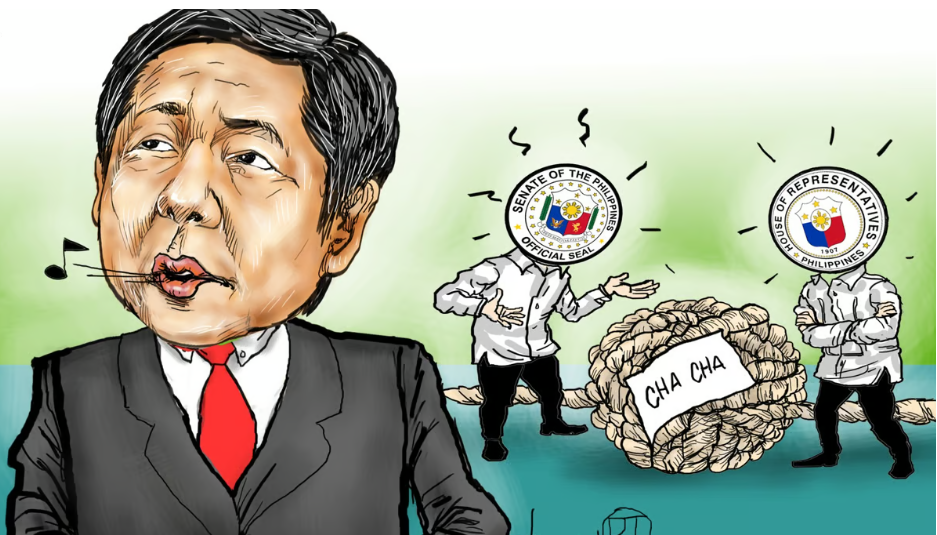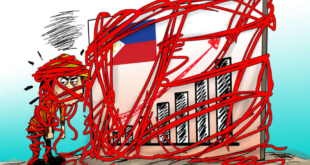The House remained adamant about pushing the PI that takes a different route towards cha-cha, made the Senate shelve deliberations of RBH 6.

President Ferdinand “Bongbong” Marcos Jr. must state a clear position in charter change, or cha-cha, to put an end to the bitter war of words between the Senate and House of Representatives and thus allow legislators to focus on their work amid persisting domestic problems on high prices and calamities and the external threats.
Senate President Migz Zubiri had stated what constitutes a position of Marcos, however vague it was, that he supports cha-cha but is limited to amending the economic provisions in contrast to the House-backed People’s Initiative that is seeking a rewording of the provisions on the holding of a Constituent Assembly to usher in a unicameral vote.
Two former Senate leaders, Franklin Drilon and Vicente Sotto III, voiced identical views that the President can mediate through a firm statement to both chambers on his stand.
“The President can do it,” Drilon said. Sotto similarly pointed out, “The only person who could put a stop to the wrangling is the President.”
Marcos earlier met with Zubiri and Speaker Ferdinand Martin Romualdez last January. He directed Zubiri to take the lead on the Resolution of Both Houses 6, which was geared towards amending the Charter’s economic provisions.
The amendment would, in effect, tweak the provisions to allow the government leeway on the contentious limits on ownership of companies engaged in critical economic sectors.
“In that meeting, I defended the position of the Senate that as far as we are concerned, their plan is unconstitutional because we are a bicameral system of government,” Zubiri said in a news conference in January.
Yet, the House remained adamant about pushing the PI that takes a different route towards cha-cha, making the Senate shelve deliberations of RBH 6.
The Senate’s suspicion that the House was bent on clipping its authority through a one-chamber vote resulted in friction between both chambers, costing Congress precious time devoted to exchanging unsavory words.
Drilon said the quarrel was unfortunate and disruptive.
According to Sotto, the bickering stems from the PI and the senators’ suspicions that “some members of the House of Representatives are pushing it.”
The check and balance mechanism under a bicameral Congress is facing a threat with the PI move that, if successful, will be handed over to the House, which has a superior number compared to the 24 senators.
Former members of the Supreme Court expressed their belief during a recent Senate public hearing that the intent of the PI proponents was evident as it was reflected in the aim of revising the Constitution’s wording to specify Congress’ action when acting as a Constituent Assembly or con-ass.
Mendoza and the other magistrates said that the Constitution’s intent on having a bicameral Congress was that the changes in the Charter under a con-ass should be made through a joint session, voting separately.
Under con-ass, a three-fourths vote in Congress is needed to introduce changes in the Charter, but it needed to be stated if the process should be through joint or separate voting in the two chambers.
The PI is proposing the rewording of a portion of the Charter to specify a unicameral action.
The underlying reason is thus revealed, which is to change the procedure. To Mendoza, this is the most evident proof that those who drafted the provision for a con-ass implied a joint session but with the chambers voting separately.
He gave an example to illustrate best the application of the definition of two chambers of Congress after World War 2.
Ex-Chief Justice Hilario Davide added that PI cannot be in the process of the proposed changes. “The moment that any particular principle or policy is changed, it would be a revision and not an amendment,” he said.
Former SC Associate Justice Adolf Azcuna said that the heated situation can be resolved through the simple act of both chambers meeting and deciding whether to push through with cha-cha but with the vote maintained separately.
In gist, Marcos can end the feud by making his voice heard, clearly.
*****
Credit belongs to: tribune.net.ph
 Atin Ito First Filipino Community Newspaper in Ontario
Atin Ito First Filipino Community Newspaper in Ontario






